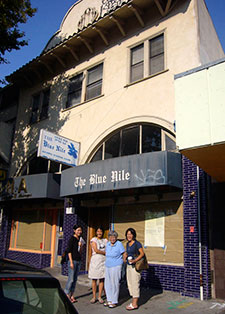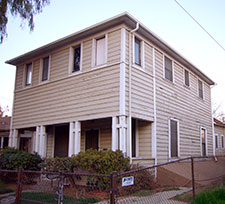
What is historic preservation?Fundamentally, the field of historic preservation has evolved as a way to protect buildings, structures and landscapes that hold meaning to a community and its heritage. Early phases of the preservation movement tended to focus on high-style buildings and those associated with powerful elites; more recently the field has encompassed many more efforts to recognize and protect sites that reflect diverse social and cultural histories. However, many people still perceive the preservation movement as not representing their interests, particularly as discussion moves into the contentious terrain of property rights. The Los Angeles Conservancy website has an excellent fact sheet addressing common concerns in their The Top Ten Myths About Historic Preservation. How do I nominate a building as a historic landmark?
You may consider a nomination on the local, state, or national level. Local preservation offers the most direct protection and stewardship; the Planning Department of your local city or county will be able to tell you whether there is a historic preservation program in place. State or national designation may offer a level of significance to expedite a local nomination, and avenues for financial support such as historic tax credits or a more flexible building code. What is significance?The two primary tasks for developing a landmark nomination are: documenting the historic significance of a building or site, and establishing its physical integrity in relation to the “period of significance.” Criteria for significance established by The National Register of Historic Places has become the foundation for most state and local preservation program. National Register criteria are organized into four categories to assess whether a building, structure or site:
A Is associated with events that have made a significant contribution to the broad patterns of our history; or
B Is associated with the lives of persons significant in our past; or C Embodies the distinctive characteristics of a type, period, or method of construction, or that represent the work of a master, or that possess high artistic values, or that represent a significant and distinguishable entity whose components may lack individual distinction; or D Has yielded or may be likely to yield, information important in prehistory or history. Japantowns obviously fall under Asian Ethnic Heritage Area of Significance already identified by the National Register. But, depending on the property, a resource may also fall under additional areas of significance such as Agriculture, Architecture, Commerce, Education, Entertainment/Recreation, Health/Medicine, Industry, Landscape Architecture, Maritime History, Performing Arts, Religion, Social History and others. What is integrity?
At left, the Harada House in Riverside, California has been designated a National Historic Landmark. To read more about this landmark, go here. PHOTO-TOP: View of Oda's Barbershop on Watsonville's Main Street. The shop closed in 2007. ABOUT THE PRESERVATION TOOLKIT HOW DO I RESEARCH A BUILDING OR JAPANTOWN NEIGHBORHOOD? HOW DO I CONDUCT AN ORAL HISTORY INTERVIEW? WHAT IS HISTORIC PRESERVATION? WHAT IF A HISTORIC RESOURCE IS THREATENED?
National DesignationThe National Park Service administers the National Register of Historic Places (NRHP) which is the nation's official list of historic resources — buildings, structures, objects, sites and districts – deemed worthy of preservation. More information on the National Register can be found here. This site contains the NRHP listing of designated properties (National Register Information Service), travel itineraries, theme studies and information on the National Historic Landmark program, and the invaluable National Register bulletins, as well as other publications. National Register nomination forms and information are available from the State Office of Historic Preservation. The State Office staff reviews the nomination and then submits it to the State Historical Resources Commission, which meets quarterly. If approved, the nomination is sent to the National Register in Washington, D.C. The owner must consent to the listing in the Register; even if the owner objects, the building becomes officially "determined eligible" for the Register, which has the same impact of triggering environmental review for alterations to the property. Benefits of listing: National Register listing allows owners of historic buildings to take advantage of the 20% federal rehabilitation tax credit, one of the most important financial incentives for rehabilitating historic buildings. Listed properties may also use the California Historic Building Code, a more flexible alternative to standard building codes. Contrary to popular conception, there are generally not large sums of grant funding available to assist owners and local agencies in rehabilitating National Register properties. National Register listing does not provide an ironclad guarantee that a building cannot be demolished or significantly altered. However, listing in the National Register does automatically trigger environmental review in California for projects which have other discretionary actions associated with them. Resources do not need to be locally designated before being nominated to a state program nor do they need to be registered at the state level before being nominated to the National Register. State DesignationThe California Register of Historical Resources is our state's guide to California's significant historic and archaeological resources. The California State Office of Historic Preservation (OHP) in Sacramento administers the Register. Their website has many resources including detailed information on documenting and nominating historic resources to the California Register, news about upcoming workshops and trainings, assistance to local governments, awards and grant programs. Historic buildings may be nominated to the California Register by local governments, private organizations, or individual citizens. All properties listed on, or formally determined eligible for the National Register of Historic Places are automatically listed in the California Register. In many cities that do not have historic preservation ordinances, the California Register provides an important statewide resource for official historic recognition. Applications are made to the State Office of Historic Preservation. The Office of Historic Preservation has four different registration programs: California Points of Historical Interest, California Register of Historical Resources, and National Register of Historic Places. Local DesignationLandmark designation at the local level generally offers the most protection to historic resources. Your city or county may have adopted a historic preservation ordinance with guidelines for designating and protecting historic buildings, structures and landscapes. Contacting the local planning department or the State Office of Historic Preservation will help you determine what local programs may apply. EXAMPLES OF LANDMARK DESIGNATIONSFor examples of local, state and national landmark applications for Japanese American heritage sites see: LOCAL: JACL Hall, City of Monterey STATE: Former Site of Vacaville Buddhist Church, California Point of Historical Interest, NATIONAL: Castroville Japanese School, National Register of Historic Places. |
||
 Anyone can prepare a landmark nomination with some general information — a building description and photo, historical information, and documentation of the building’s significance. However, there also may be people with preservation experience or knowledge (city staff, historians, students) that may be willing to assist you. Local heritage organizations can be of great support in developing nominations and advocating for them as a commission or public agency reviews them.
Anyone can prepare a landmark nomination with some general information — a building description and photo, historical information, and documentation of the building’s significance. However, there also may be people with preservation experience or knowledge (city staff, historians, students) that may be willing to assist you. Local heritage organizations can be of great support in developing nominations and advocating for them as a commission or public agency reviews them.  To be successfully considered for landmark status, a historic resource must demonstrate physical connection to the time period of its historic significance.Integrity is evaluated according to several aspect including location, design, setting, materials, workmanship, feeling, and association.
To be successfully considered for landmark status, a historic resource must demonstrate physical connection to the time period of its historic significance.Integrity is evaluated according to several aspect including location, design, setting, materials, workmanship, feeling, and association.